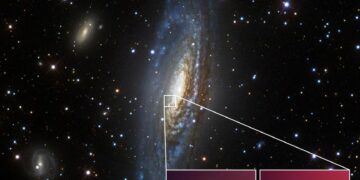Supernovae are among the most spectacular and powerful events in the universe. These colossal explosions mark the dramatic death of massive stars, often leaving behind dense remnants like neutron stars or black holes. However, some supernovae defy expectations, and one such case has baffled scientists for years—SN 2014C.
The Unexpected Evolution of SN 2014C
When SN 2014C was first observed in 2014, it was classified as a Type Ib supernova, meaning it showed no signs of hydrogen in its spectrum. Type Ib supernovae are thought to originate from massive stars that have lost their hydrogen envelopes, often through interactions with a companion star in a binary system. But something strange happened with SN 2014C—over the next few months, its spectrum evolved dramatically. Hydrogen lines appeared, and its behavior aligned more closely with Type IIn supernovae, which are known for strong interactions with a dense hydrogen-rich environment.
Astronomers soon realized that this supernova had ejected its hydrogen shell long before exploding but then slammed into this material post-explosion.
What Makes SN 2014C So Special?
A Supernova With a Hidden Past
SN 2014C’s transformation is a clue to its unusual progenitor star. Normally, Type Ib supernovae come from Wolf-Rayet stars, which have shed their hydrogen layers through stellar winds or interactions with a companion. However, the presence of a thick hydrogen-rich circumstellar medium (CSM) suggests that the progenitor of SN 2014C underwent significant mass loss just before the explosion, creating a dense shell of hydrogen around it. This is unusual because it implies that the progenitor was still shedding its outer layers even in its final moments.
The Collision That Revealed the Truth
The key to SN 2014C’s transformation was its violent collision with its own ejected material. When the supernova’s ejecta expanded outward, it eventually reached the dense CSM, leading to a secondary shock wave. This interaction not only caused the unexpected hydrogen-rich spectrum but also prolonged the supernova’s brightness longer than expected. The light curve variations seen in SN 2014C are a direct consequence of this prolonged shock interaction.
How Scientists Uncovered SN 2014C’s Secrets
To understand this unique event, researchers relied on data collected from a range of telescopes, including the Lijiang 2.4-meter telescope, the Hubble Space Telescope (HST), and radio and infrared observatories. Each wavelength provided different insights:
- Optical and ultraviolet observations tracked changes in its spectral signature.
- Radio and X-ray data confirmed ongoing interactions between the expanding ejecta and the dense surrounding hydrogen.
- Infrared imaging suggested the presence of dust, which formed as the shock wave cooled.
These observations helped scientists reconstruct the final years of the progenitor star, revealing that it likely lost its hydrogen shell within the last few hundred years before its explosion.
The Role of Hydrodynamic Models
Scientists also used computational models to simulate how the supernova ejecta interacted with the CSM. These models incorporated radioactive decay energy and delayed CSM interaction, successfully reproducing the light curve variations observed in SN 2014C.
Implications for Stellar Evolution
SN 2014C challenges the traditional classifications of supernovae. It suggests that some stars may undergo rapid and significant mass loss just before exploding, rather than gradually shedding their outer layers over millions of years. This means we may need new categories to describe supernovae that exhibit hybrid properties.
One possibility is that SN 2014C’s progenitor was part of a binary system, where a companion star stripped away its hydrogen envelope. However, the presence of a thick, structured CSM indicates a more chaotic and episodic mass loss, potentially due to sudden outbursts or an unstable stellar wind phase.
Why This Discovery Matters
SN 2014C is not just an anomaly—it is a critical piece in the puzzle of how stars die. Studying its evolution provides direct evidence that some massive stars experience a turbulent and unpredictable final phase, which influences the nature of their explosions.
This discovery also affects our understanding of:
- Galactic chemical enrichment: Supernovae play a role in seeding galaxies with heavy elements.
- Black hole formation: Understanding supernova mechanisms helps refine models of how stars collapse into neutron stars or black holes.
- Future transient astronomy: SN 2014C highlights the importance of long-term supernova monitoring, as some events change over time rather than fitting neatly into predefined categories.
What’s Next?
To fully understand SN 2014C, astronomers need to find more examples of similar supernovae. Future missions, such as NASA’s James Webb Space Telescope (JWST) and the Vera C. Rubin Observatory, will help detect and analyze more “chameleon” supernovae in different galaxies.
Advanced hydrodynamic and radiation transfer simulations will help refine our models of how supernovae interact with their environments. These simulations will provide better predictions for the diversity of supernova light curves and spectral changes.
Conclusion: A Supernova That Changed the Rules
SN 2014C is a rare, shape-shifting supernova that defied classification, revealing new insights into the life and death of massive stars. Its ability to transform over time has expanded our understanding of stellar evolution and the complex interactions between dying stars and their surrounding environments.
Reference:
Qian Zhai et al, SN 2014C: A Metamorphic Supernova Exploded in the Intricate and Hydrogen-rich Surroundings, The Astrophysical Journal (2025). DOI: 10.3847/1538-4357/ad9c76



















